2014 MITSUBISHI OUTLANDER SPORT brake
[x] Cancel search: brakePage 284 of 388
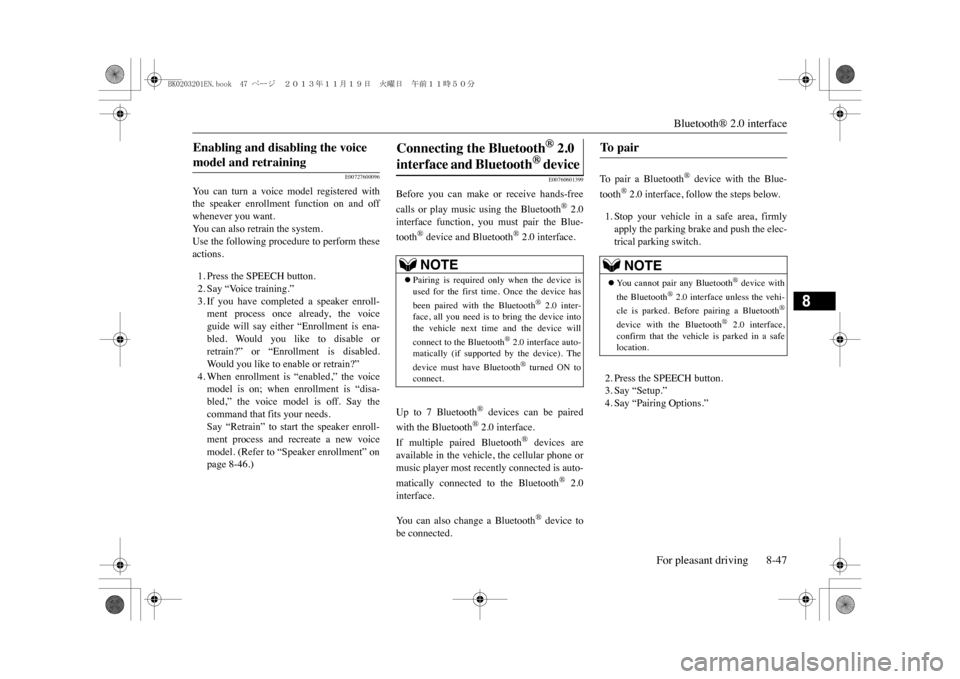
Bluetooth® 2.0 interface
For pleasant driving 8-47
8
E00727600096
Yo u c a n t u r n a v o i c e m o d e l r e g i s t e r e d w i t hthe speaker enrollment function on and offwhenever you want.Yo u c a n a l s o r e t r a i n t h e s y s t e m .Use the following procedure to perform theseactions.1. Press the SPEECH button.2. Say “Voice training.”3. If you have completed a speaker enroll-ment process once already, the voiceguide will say either “Enrollment is ena-bled. Would you like to disable orretrain?” or “Enrollment is disabled.Wo u l d y o u l i k e t o e n a b l e o r r e t r a i n ? ”4. When enrollment is “enabled,” the voicemodel is on; when enrollment is “disa-bled,” the voice model is off. Say thecommand that fits your needs. Say “Retrain” to start the speaker enroll-ment process and recreate a new voicemodel. (Refer to “Speaker enrollment” onpage 8-46.)
E00760601399
Before you can make or receive hands-freecalls or play music using the Bluetooth
® 2.0
interface function, you must pair the Blue-tooth
® device and Bluetooth
® 2.0 interface.
Up to 7 Bluetooth
® devices can be paired
with the Bluetooth
® 2.0 interface.
If multiple paired Bluetooth
® devices are
available in the vehicle, the cellular phone ormusic player most recently connected is auto-matically connected to the Bluetooth
® 2.0
interface.Yo u c a n a l s o c h a n g e a B l u e t o o t h
® device to
be connected.
To p a i r a B l u e t o o t h
® device with the Blue-
tooth
® 2.0 interface, follow the steps below.
1. Stop your vehicle in a safe area, firmlyapply the parking brake and push the elec-trical parking switch.2. Press the SPEECH button.3. Say “Setup.”4. Say “Pairing Options.”
Enabling and disabling the voice model and retraining
Connecting the Bluetooth
® 2.0
interface and Bluetooth
® d e v i c e
NOTE
�zPairing is required only when the device isused for the first time. Once the device hasbeen paired with the Bluetooth
® 2.0 inter-
face, all you need is to bring the device intothe vehicle next time and the device willconnect to the Bluetooth
® 2.0 interface auto-
matically (if supported by the device). Thedevice must ha
ve Bluetooth
® turned ON to
connect.
To p a i r
NOTE
�zYo u c a n n o t p a i r a n y B l u e t o o t h
® device with
the Bluetooth
® 2.0 interface unless the vehi-
cle is parked. Before pairing a Bluetooth
®
device with the Bluetooth
® 2.0 interface,
confirm that the vehicle is parked in a safelocation.
BK0203201EN.book 47 ページ 2013年11月19日 火曜日 午前11時50分
Page 313 of 388
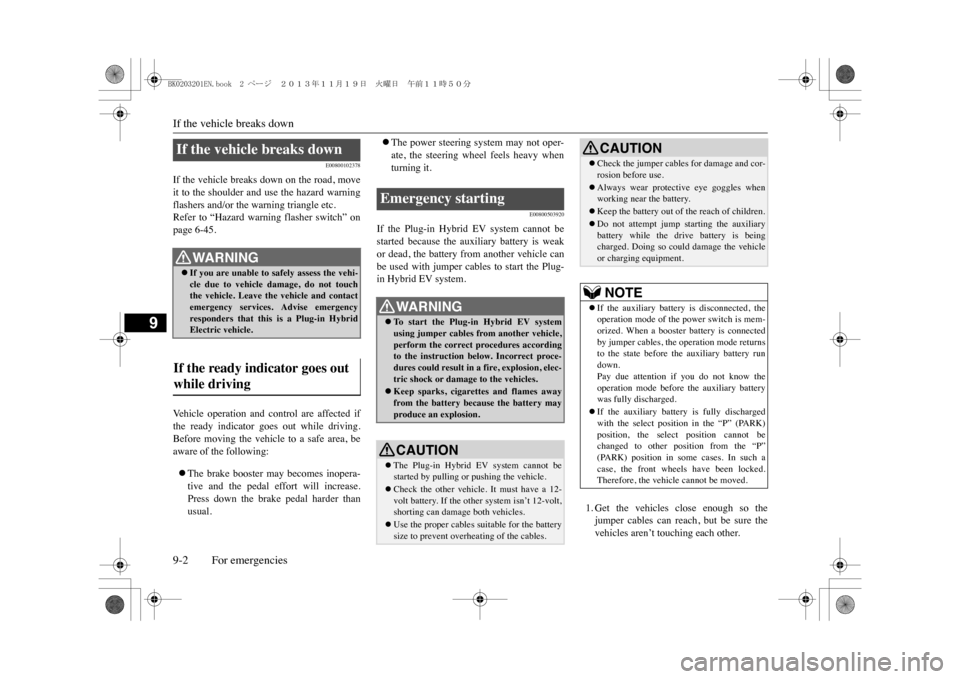
If the vehicle breaks down9-2 For emergencies
9
E00800102378
If the vehicle breaks down on the road, moveit to the shoulder and use the hazard warningflashers and/or the warning triangle etc.Refer to “Hazard warning flasher switch” onpage 6-45.Ve h i c l e o p e r a t i o n a n d c o n t r o l a r e a f f e c t e d i fthe ready indicator goes out while driving.Before moving the vehicle to a safe area, beaware of the following:�zThe brake booster may becomes inopera-tive and the pedal effort will increase.Press down the brake pedal harder thanusual.
�zThe power steering system may not oper-ate, the steering wheel feels heavy whenturning it.
E00800503920
If the Plug-in Hybrid EV system cannot bestarted because the auxiliary battery is weakor dead, the battery from another vehicle canbe used with jumper cables to start the Plug-in Hybrid EV system.
1. Get the vehicles close enough so thejumper cables can reach, but be sure thevehicles aren’t touching each other.
If the vehicle breaks down
WA R N I N G�zIf you are unable to safely assess the vehi-cle due to vehicle damage, do not touchthe vehicle. Leave the vehicle and contactemergency services. Advise emergencyresponders that this is a Plug-in HybridElectric vehicle.
If the ready indicator goes out while driving
Emergency starting
WA R N I N G�zTo s t a r t t h e P l u g - i n H y b r i d E V s y s t e musing jumper cables from another vehicle,perform the correct procedures accordingto the instruction below. Incorrect proce-dures could result in a fire, explosion, elec-tric shock or damage
to the vehicles.
�zKeep sparks, cigarettes and flames awayfrom the battery because the battery mayproduce an explosion.CAUTION�zThe Plug-in Hybrid EV system cannot bestarted by pulling or pushing the vehicle.�zCheck the other vehicle.
It must have a 12-
volt battery. If the other system isn’t 12-volt,shorting can damage
both vehicles.
�zUse the proper cables suitable for the batterysize to prevent overhea
ting of the cables.
�zCheck the jumper cables for damage and cor-rosion before use.�zAlways wear protect
ive eye goggles when
working near the battery.�zKeep the battery out of the reach of children.�zDo not attempt jump starting the auxiliarybattery while the drive battery is beingcharged. Doing so could damage the vehicleor charging equipment.NOTE
�zIf the auxiliary battery is disconnected, theoperation mode of the power switch is mem-orized. When a booster
battery is connected
by jumper cables, the operation mode returnsto the state before the auxiliary battery rundown.Pay due attention if you do not know theoperation mode before
the auxiliary battery
was fully discharged.�zIf the auxiliary battery is fully dischargedwith the select position in the “P” (PARK)position, the select position cannot bechanged to other position from the “P”(PARK) position in some cases. In such acase, the front wheels have been locked.Therefore, the vehicle cannot be moved.CAUTION
BK0203201EN.book 2 ページ 2013年11月19日 火曜日 午前11時50分
Page 314 of 388
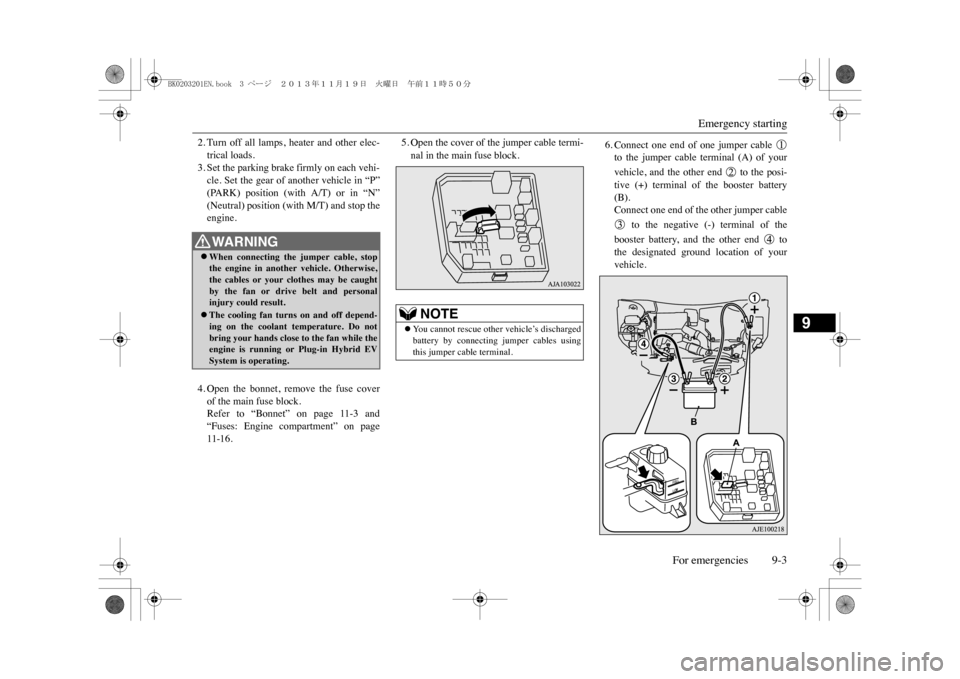
Emergency starting
For emergencies 9-3
9
2. Turn off all lamps, heater and other elec-trical loads.3. Set the parking brake firmly on each vehi-cle. Set the gear of another vehicle in “P”(PARK) position (with A/T) or in “N”(Neutral) position (with M/T) and stop theengine.4. Open the bonnet, remove the fuse coverof the main fuse block.Refer to “Bonnet” on page 11-3 and“Fuses: Engine compartment” on page11-16.
5. Open the cover of the jumper cable termi-nal in the main fuse block.
6. Connect one end of one jumper cable to the jumper cable terminal (A) of yourvehicle, and the other end to the posi-tive (+) terminal of the booster battery(B).Connect one end of the other jumper cable to the negative (-) terminal of thebooster battery, and the other end tothe designated ground location of yourvehicle.
WA R N I N G�zWhen connecting the jumper cable, stopthe engine in another vehicle. Otherwise,the cables or your cl
othes may be caught
by the fan or drive belt and personalinjury could result.�zThe cooling fan turns on and off depend-ing on the coolant temperature. Do notbring your hands close to the fan while theengine is running or Plug-in Hybrid EVSystem is operating.
NOTE
�zYo u c a n n o t r e s c u e o t h e
r vehicle’s discharged
battery by connecting jumper cables usingthis jumper cable terminal.
BK0203201EN.book 3 ページ 2013年11月19日 火曜日 午前11時50分
Page 319 of 388
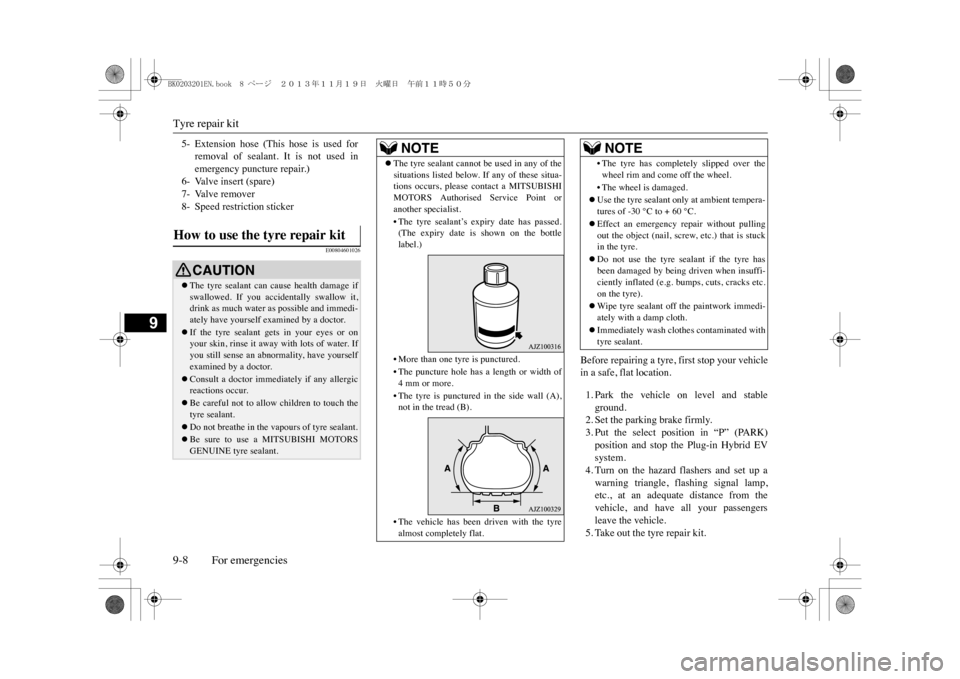
Tyre repair kit9-8 For emergencies
9
E00804601026
Before repairing a tyre, first stop your vehiclein a safe, flat location.1. Park the vehicle on level and stableground.2. Set the parking brake firmly.3. Put the select position in “P” (PARK)position and stop the Plug-in Hybrid EVsystem.4. Turn on the hazard flashers and set up awarning triangle, flashing signal lamp,etc., at an adequate distance from thevehicle, and have all your passengersleave the vehicle.5. Take out the tyre repair kit.
5- Extension hose (This hose is used for
removal of sealant. It is not used inemergency puncture repair.)
6- Valve insert (spare)7- Valve remover8- Speed restriction stickerHow to use the tyre repair kit
CAUTION�zThe tyre sealant can cause health damage ifswallowed. If you accidentally swallow it,drink as much water as possible and immedi-ately have yourself examined by a doctor.�zIf the tyre sealant gets in your eyes or onyour skin, rinse it away
with lots of water. If
you still sense an abnormality, have yourselfexamined by a doctor.�zConsult a doctor immediately if any allergicreactions occur.�zBe careful not to allow children to touch thetyre sealant.�zDo not breathe in the vapours of tyre sealant.�zBe sure to use a MITSUBISHI MOTORSGENUINE tyre sealant.
NOTE
�zThe tyre sealant cannot be used in any of thesituations listed below. If any of these situa-tions occurs, please contact a MITSUBISHIMOTORS Authorised Service Point oranother specialist.•The tyre sealant’s e
xpiry date has passed.
(The expiry date is shown on the bottlelabel.)•More than one tyre is punctured.•The puncture hole has
a length or width of
4 mm or more.•The tyre is punctured in the side wall (A),not in the tread (B).•The vehicle has been driven with the tyrealmost completely flat.
•The tyre has completely slipped over thewheel rim and come off the wheel.•The wheel is damaged.�zUse the tyre sealant only at ambient tempera-tures of -30 °C to + 60 °C.�zEffect an emergency repair without pullingout the object (nail, screw, etc.) that is stuckin the tyre.�zDo not use the tyre sealant if the tyre hasbeen damaged by being driven when insuffi-ciently inflated (e.g. bumps, cuts, cracks etc.on the tyre).�zWipe tyre sealant off the paintwork immedi-ately with a damp cloth.�zImmediately wash clot
hes contaminated with
tyre sealant.NOTE
BK0203201EN.book 8 ページ 2013年11月19日 火曜日 午前11時50分
Page 325 of 388
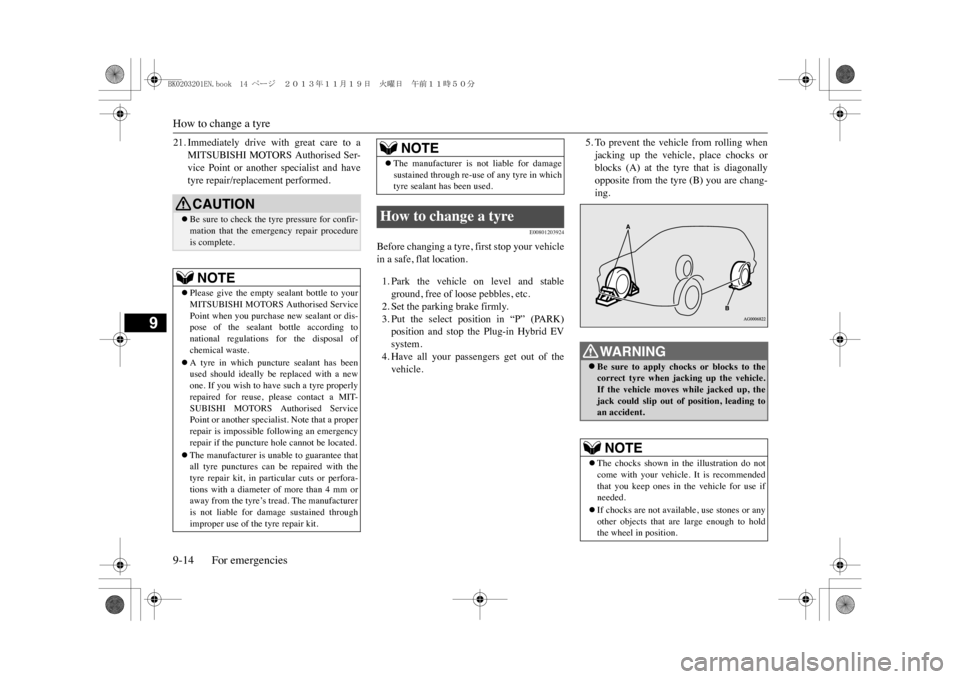
How to change a tyre9-14 For emergencies
9
21. Immediately drive with great care to a
MITSUBISHI MOTORS Authorised Ser-vice Point or another specialist and havetyre repair/replacement performed.
E00801203924
Before changing a tyre, first stop your vehiclein a safe, flat location.1. Park the vehicle on level and stableground, free of loose pebbles, etc.2. Set the parking brake firmly.3. Put the select position in “P” (PARK)position and stop the Plug-in Hybrid EVsystem.4. Have all your passengers get out of thevehicle.
5. To prevent the vehicle from rolling whenjacking up the vehicle, place chocks orblocks (A) at the tyre that is diagonallyopposite from the tyre (B) you are chang-ing.
CAUTION�zBe sure to check the tyre pressure for confir-mation that the emergency repair procedureis complete.NOTE
�zPlease give the empty sealant bottle to yourMITSUBISHI MOTORS Authorised ServicePoint when you purchase new sealant or dis-pose of the sealant bottle according tonational regulations for the disposal ofchemical waste.�zA tyre in which puncture sealant has beenused should ideally be
replaced with a new
one. If you wish to have
such a tyre properly
repaired for reuse, please contact a MIT-SUBISHI MOTORS Authorised ServicePoint or another specialist. Note that a properrepair is impossible fo
llowing an emergency
repair if the puncture hole cannot be located.�zThe manufacturer is unable to guarantee thatall tyre punctures can be repaired with thetyre repair kit, in particular cuts or perfora-tions with a diameter
of more than 4 mm or
away from the tyre’s tread. The manufactureris not liable for damage sustained throughimproper use of the tyre repair kit.
�zThe manufacturer is not liable for damagesustained through re-use of any tyre in whichtyre sealant has been used.
How to change a tyre
NOTE
WA R N I N G�zBe sure to apply choc
ks or blocks to the
correct tyre when jacking up the vehicle.If the vehicle moves while jacked up, thejack could slip out of
position, leading to
an accident.NOTE
�zThe chocks shown in the illustration do notcome with your vehicle. It is recommendedthat you keep ones in the vehicle for use ifneeded.�zIf chocks are not available, use stones or anyother objects that are large enough to holdthe wheel in position.
BK0203201EN.book 14 ページ 2013年11月19日 火曜日 午前11時50分
Page 332 of 388
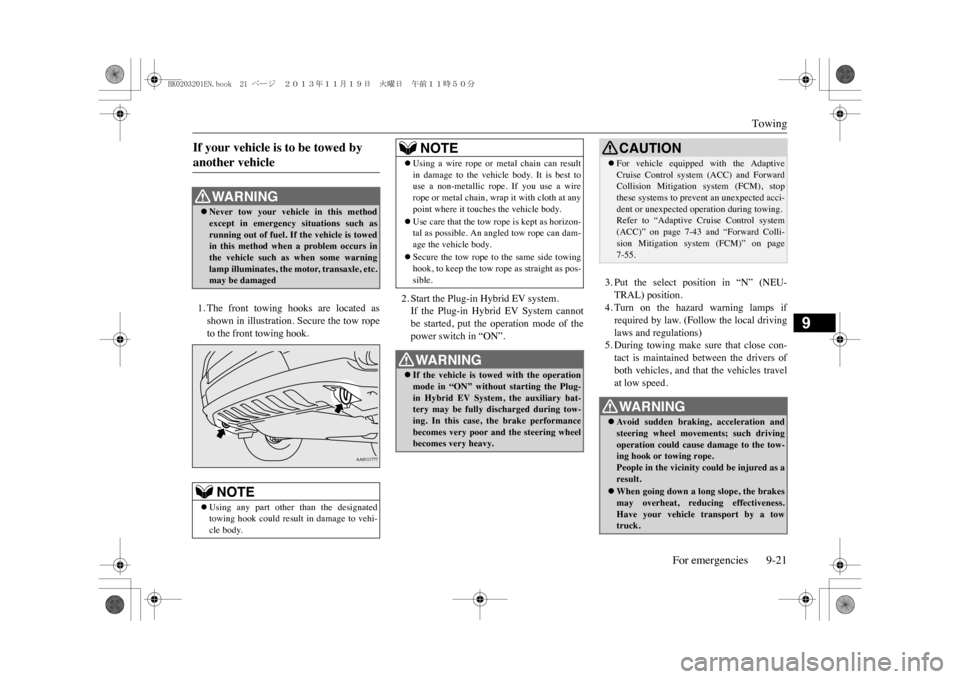
Towing
For emergencies 9-21
9
1. The front towing hooks are located asshown in illustration. Secure the tow ropeto the front towing hook.
2. Start the Plug-in Hybrid EV system.If the Plug-in Hybrid EV System cannotbe started, put the operation mode of thepower switch in “ON”.
3. Put the select position in “N” (NEU-TRAL) position.4. Turn on the hazard warning lamps ifrequired by law. (Follow the local drivinglaws and regulations)5. During towing make sure that close con-tact is maintained between the drivers ofboth vehicles, and that the vehicles travelat low speed.
If your vehicle is to be towed by another vehicle
WA R N I N G�zNever tow your vehicle in this methodexcept in emergency situations such asrunning out of fuel. If
the vehicle is towed
in this method when
a problem occurs in
the vehicle such as when some warninglamp illuminates, the motor, transaxle, etc.may be damagedNOTE
�zUsing any part other than the designatedtowing hook could result in
damage to vehi-
cle body.
�zUsing a wire rope or metal chain can resultin damage to the vehicle body. It is best touse a non-metallic rope. If you use a wirerope or metal chain, wrap it with cloth at anypoint where it touches the vehicle body.�zUse care that the tow rope is kept as horizon-tal as possible. An angled tow rope can dam-age the vehicle body.�zSecure the tow rope to the same side towinghook, to keep the tow rope
as straight as pos-
sible.WA R N I N G�zIf the vehicle is towed with the operationmode in “ON” withou
t starting the Plug-
in Hybrid EV System, the auxiliary bat-tery may be fully discharged during tow-ing. In this case, the brake performancebecomes very poor and the steering wheelbecomes very heavy.NOTE
CAUTION�zFor vehicle equipped with the AdaptiveCruise Control system (ACC) and ForwardCollision Mitigation system (FCM), stopthese systems to prevent an unexpected acci-dent or unexpected op
eration during towing.
Refer to “Adaptive Cruise Control system(ACC)” on page 7-43 and “Forward Colli-sion Mitigation system (FCM)” on page7-55.WA R N I N G�zAv o i d s u d d e n b r a k i n g ,
acceleration and
steering wheel movements; such drivingoperation could cause damage to the tow-ing hook or towing rope.People in the vicinity could be injured as aresult.�zWhen going down a long slope, the brakesmay overheat, reducing effectiveness.Have your vehicle transport by a towtruck.
BK0203201EN.book 21 ページ 2013年11月19日 火曜日 午前11時50分
Page 333 of 388
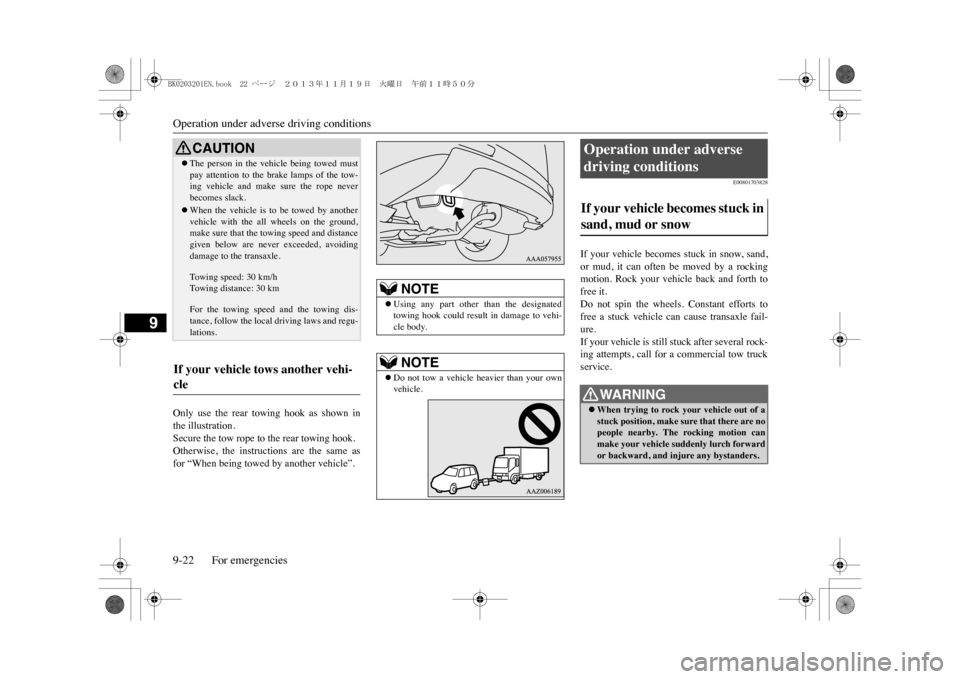
Operation under adverse driving conditions9-22 For emergencies
9
Only use the rear towing hook as shown inthe illustration.Secure the tow rope to the rear towing hook.Otherwise, the instructions are the same asfor “When being towed by another vehicle”.
E00801703828
If your vehicle becomes stuck in snow, sand,or mud, it can often be moved by a rockingmotion. Rock your vehicle back and forth tofree it.Do not spin the wheels.
Constant efforts to
free a stuck vehicle can cause transaxle fail-ure.If your vehicle is still stuck after several rock-ing attempts, call for a commercial tow truckservice.
CAUTION�zThe person in the vehicle being towed mustpay attention to the brake lamps of the tow-ing vehicle and make sure the rope neverbecomes slack.�zWhen the vehicle is to be towed by anothervehicle with the all wheels on the ground,make sure that the towing speed and distancegiven below are neve
r exceeded, avoiding
damage to the transaxle.To w i n g s p e e d : 3 0 k m / hTo w i n g d i s t a n c e : 3 0 k mFor the towing speed and the towing dis-tance, follow the local driving laws and regu-lations.
If your vehicle tows another vehi-cle
NOTE
�zUsing any part
other than the designated
towing hook could result in damage to vehi-cle body.NOTE
�zDo not tow a vehicle heavier than your ownvehicle.
Operation under adverse driving conditions If your vehicle becomes stuck in sand, mud or snow
WA R N I N G�zWhen trying to rock your vehicle out of astuck position, make sure that there are nopeople nearby. The rocking motion canmake your vehicle suddenly lurch forwardor backward, and inju
re any bystanders.
BK0203201EN.book 22 ページ 2013年11月19日 火曜日 午前11時50分
Page 334 of 388
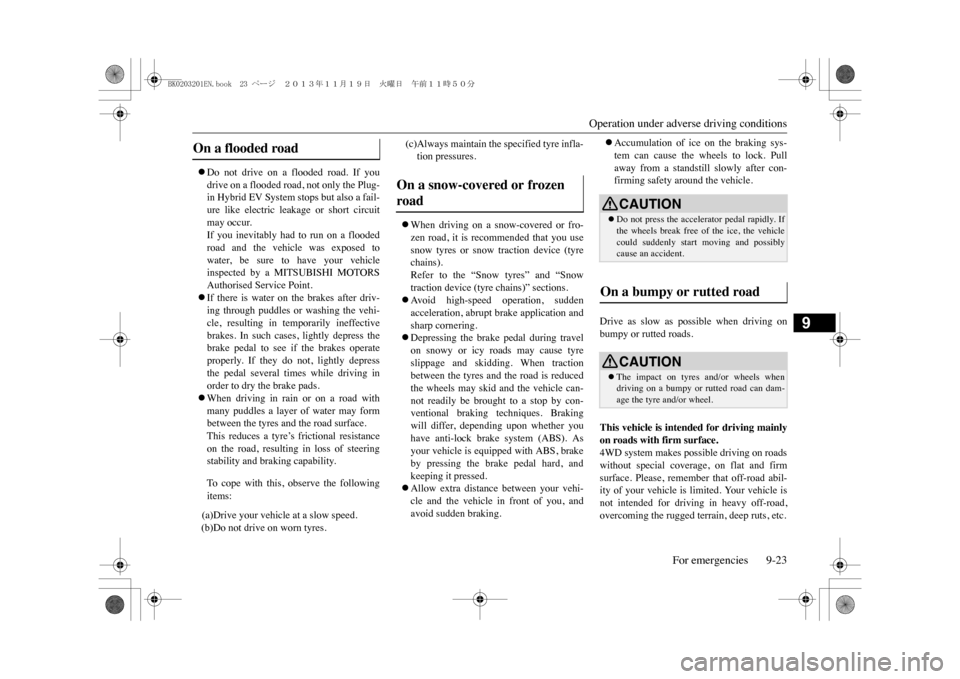
Operation under adverse driving conditions
For emergencies 9-23
9
�zDo not drive on a flooded road. If youdrive on a flooded road, not only the Plug-in Hybrid EV System stops but also a fail-ure like electric leakage or short circuitmay occur.If you inevitably had to run on a floodedroad and the vehicle was exposed towater, be sure to have your vehicleinspected by a MITSUBISHI MOTORSAuthorised Service Point.�zIf there is water on the brakes after driv-ing through puddles or washing the vehi-cle, resulting in temporarily ineffectivebrakes. In such cases, lightly depress thebrake pedal to see if the brakes operateproperly. If they do not, lightly depressthe pedal several times while driving inorder to dry the brake pads.�zWhen driving in rain or on a road withmany puddles a layer of water may formbetween the tyres and the road surface.This reduces a tyre’s frictional resistanceon the road, resulting in loss of steeringstability and braking capability.To c o p e w i t h t h i s , o b s e r v e t h e f o l l o w i n gitems:
�zWhen driving on a snow-covered or fro-zen road, it is recommended that you usesnow tyres or snow traction device (tyrechains).Refer to the “Snow tyres” and “Snowtraction device (tyre chains)” sections.�zAv o i d h i g h - s p e e d o p e r a t i o n , s u d d e nacceleration, abrupt brake application andsharp cornering.�zDepressing the brake pedal during travelon snowy or icy roads may cause tyreslippage and skidding. When tractionbetween the tyres and the road is reducedthe wheels may skid and the vehicle can-not readily be brought to a stop by con-ventional braking techniques. Brakingwill differ, depending upon whether youhave anti-lock brake system (ABS). Asyour vehicle is equipped with ABS, brakeby pressing the brake pedal hard, andkeeping it pressed.�zAllow extra distance between your vehi-cle and the vehicle in front of you, andavoid sudden braking.
�zAccumulation of ice on the braking sys-tem can cause the wheels to lock. Pullaway from a standstill slowly after con-firming safety around the vehicle.
Drive as slow as possible when driving onbumpy or rutted roads.This vehicle is intended for driving mainlyon roads with firm surface.4WD system makes possible driving on roadswithout special coverage, on flat and firmsurface. Please, remember that off-road abil-ity of your vehicle is limited. Your vehicle isnot intended for driving in heavy off-road,overcoming the rugged terrain, deep ruts, etc.
On a flooded road (a)Drive your vehicle at a slow speed.(b)Do not drive on worn tyres.
(c)Always maintain the specified tyre infla-tion pressures.
On a snow-covered or frozen road
CAUTION�zDo not press the accelerator pedal rapidly. Ifthe wheels break free of the ice, the vehiclecould suddenly start
moving and possibly
cause an accident.
On a bumpy or rutted road
CAUTION�zThe impact on tyres and/or wheels whendriving on a bumpy or rutted road can dam-age the tyre and/or wheel.
BK0203201EN.book 23 ページ 2013年11月19日 火曜日 午前11時50分